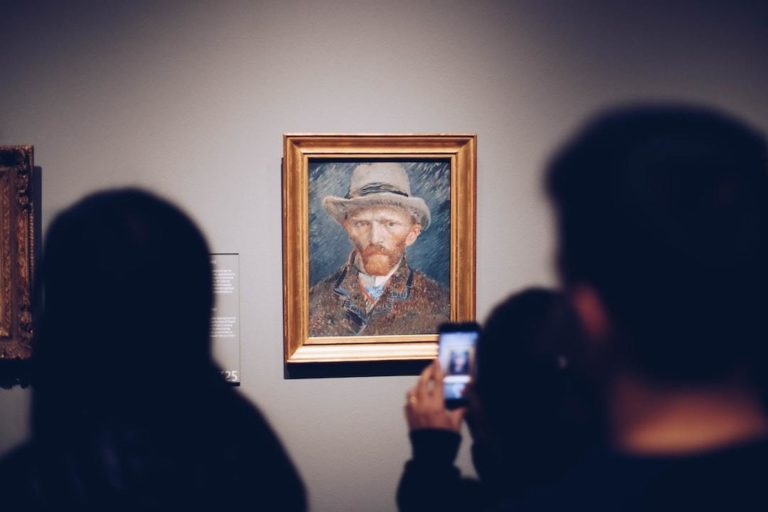Bauhaus Art Design Movement: Its History and Influences
The Bauhaus art design movement, a revolutionary surge in the early 20th century that reverberated around the world, revolutionized our notion of modern art and design. This German school brought together fine arts and crafts under one roof, blending them into an innovative artistic language.
The Bauhaus Art Design Movement, emphasizing functionality and minimalism, revolutionized design principles and continues to influence modern aesthetics. Its impact can be seen in various fields, inspiring architects, designers, and artists worldwide. The Bauhaus remains an iconic and influential movement in the art world, shaping contemporary design practices.
Founded by Architect Walter Gropius, the Bauhaus style is characterized by its functional simplicity and abstract shapes. It was not merely about creating aesthetically pleasing objects; it emphasized utility through design.
In this blog post, we look at the history of this influential movement. From its inception to its pioneers like Marcel Breuer, who shaped it with their specific style, till its eventual end – each facet offers intriguing insights for any art lover or someone seeking creative travel experiences.

Table of Contents:
- Bauhaus: The Art and Design Revolution
- The Visionaries Behind Bauhaus
- Who Started the Bauhaus Movement?
- When Did the Bauhaus Movement Begin?
- Who Started the Bauhaus Movement?
- How Bauhaus Movement Ended?
- FAQs in Relation to Bauhaus Art Design Movement
- Conclusion
Bauhaus: The Art and Design Revolution
Bauhaus: the art and design movement that changed the game. It was all about simplicity, functionality, and mass production. No frills, just clean lines and primary colors. From furniture to graphic design, its influence can still be seen today.
The Philosophy Behind Bauhaus
Bauhaus was all about practicality over luxury. It rejected unnecessary ornamentation and embraced minimalism. Form and function were in perfect harmony, making good design accessible to everyone.
Influence on Modern Design
From IKEA’s flat-pack furniture to Apple’s sleek product range, Bauhaus principles are everywhere. It’s the reason why modernist aesthetics are so popular today.
The Visionaries Behind Bauhaus
Walter Gropius founded the movement in 1919. He believed artists should collaborate with engineers and architects to create purposeful societal designs.
Johannes Itten: The Color Theory Master
Johannes Itten was one of Gropius’ first hires. He developed color theory courses that greatly influenced students’ understanding of color relations and composition.
Laszlo Moholy-Nagy: The Innovative Educator
Laszlo Moholy-Nagy transformed photography into an accepted art form and promoted experimental learning methods based on material studies. He was a true pioneer.
Who Started the Bauhaus Movement?
The Bauhaus movement was the brainchild of Walter Gropius – a German architect who wanted to bridge the gap between art and industry.
Walter Gropius: The Visionary Behind Bauhaus
Gropius believed in creating functional designs that were both practical and aesthetically pleasing. He founded the Bauhaus School in Weimar, Germany in 1919 with an aim to unify all forms of creative expression into a single discipline.
Johannes Itten: The Color Theory Expert
Johannes Itten, an artist and theorist, played a significant role in shaping the early years of Bauhaus. His innovative theories on color and form still influence modern design education today.
Laszlo Moholy-Nagy: The Multi-Disciplinary Artist
Laszlo Moholy-Nagy, a Hungarian-born artist, brought fresh perspectives into play at Bauhaus school when he took over as headmaster. His works embodied what it meant to be part of this groundbreaking movement – innovative yet functional while remaining true to principles laid down by its founder Walter Gropius.
When Did the Bauhaus Movement Begin?
In 1919, the Bauhaus movement was initiated in Germany following World War I by architect Walter Gropius who founded the Bauhaus School in Weimar. Architect Walter Gropius founded the Bauhaus School in Weimar, with a vision to unite fine arts and practical crafts. He wanted to create designs that were both functional and beautiful, hence the name ‘bau’ (building) and ‘haus’ (house).
A New Era in Design
From 1919 to 1925, the school was in Weimar before moving to Dessau. During this time, the movement transitioned from romantic ideals to a more rationalist style that would define modernism. Johannes Itten introduced his revolutionary preliminary course, which every student had to pass before entering specialized workshops.
Moving Towards Modernism
In Dessau, Gropius designed iconic buildings embodying principles of functionality and simplicity. This era also saw increased emphasis on mass production techniques, reflecting industrial advancements. Marcel Breuer’s tubular steel furniture is an excellent example of traditional craft skills adapted for industrial manufacturing processes.
Berlin: The Final Chapter
In 1930, Ludwig Mies van der Rohe took over directorship after Hannes Meyer’s dismissal. This marked another phase change within Bauhaus history until its closure three years later under Nazi regime pressures.
Who Started the Bauhaus Movement?
The Bauhaus movement was a collective effort of innovative artists, architects, and designers who broke down barriers between fine arts and applied arts. Paul Klee and Wassily Kandinsky were pioneers who brought their unique styles to Bauhaus. Klee’s work incorporated abstract shapes and bold colors, while Kandinsky expressed emotions through color and form. Other notable figures include Oskar Schlemmer, Laszlo Moholy-Nagy, Johannes Itten, and Mies van der Rohe. Their collaborative efforts gave birth to iconic designs that still inspire generations today.
What Did Oskar Schlemmer Contribute to Bauhaus?
Oskar Schlemmer was known for his avant-garde costumes and stage designs, which significantly defined the aesthetics of Bauhaus theater productions.
What Was Laszlo Moholy-Nagy’s Role in Bauhaus?
Laszlo Moholy-Nagy introduced photography as an important medium within the curriculum at Bauhaus school and was instrumental in developing its metal workshop.
What Was Johannes Itten’s Contribution to Bauhaus?
Johannes Itten developed a comprehensive theory on color harmony, which continues to influence modern design practices today.
How Did Mies van der Rohe Shape Bauhaus Architecture?
Mies van der Rohe, the last director before closure due to Nazi pressure, played a significant role in shaping up the architecture department, making it globally recognized till date. Learn more about Mies Van Der Rohe’s influence on Bauhaus here.
Who Else Contributed to the Bauhaus Movement?
Other notable artists who made lasting contributions towards the development and recognition of this movement worldwide include Herbert Bayer (typography) and Marcel Breuer (furniture).
What Was the Legacy of the Bauhaus Movement?
The creative energy unleashed by these pioneering artists transformed not only how we perceive art but also our everyday surroundings, leaving behind an enduring legacy still celebrated across the globe. While their individual styles varied greatly, they all shared a common belief that art should be accessible and useful, serving practical needs besides aesthetic ones, thereby redefining traditional notions around what constitutes ‘Art’.
The Bauhaus movement was a collaborative effort of innovative artists, architects, and designers who broke down barriers between fine arts and applied arts. Pioneers such as Paul Klee and Wassily Kandinsky brought their unique styles to the movement, while Oskar Schlemmer contributed significantly to defining the aesthetics of Bauhaus theater productions. Laszlo Moholy-Nagy introduced photography as an important medium within the curriculum at Bauhaus school, Johannes Itten developed a comprehensive theory on color harmony that continues to influence modern design practices today, and Mies van der Rohe played a significant role in shaping up the architecture department. The legacy of this pioneering group transformed not only how we perceive art but also our everyday surroundings by redefining traditional notions around what constitutes ‘Art’.
How did Bauhaus Movement End?
The Bauhaus movement was too cool for the Nazis. They shut it down in 1933, calling it subversive and un-German. The school’s inclusive philosophy clashed with the Nazi’s vision of a pure Aryan society. Despite attempts to adapt, tensions continued to escalate.
A Gradual Suppression
The Nazis labeled Bauhaus as a hotbed of communist intellectualism. The school tried to appease the regime by introducing more traditional craft classes, but it didn’t work. The pressure kept mounting.
Closure Under Duress
The final blow came when the Nazis forced the closure of the school’s Dessau location in 1932. The Gestapo ordered a complete shutdown of the Berlin location within months, citing alleged activities against the state. The era-defining movement was effectively over.
Diaspora: Spreading Influence Beyond Borders
Many prominent figures associated with the movement fled the country, taking its ideals and teachings. They spread the innovative approach towards arts and architecture across the globe. Walter Gropius emigrated to the United States, where he became the head of Harvard University’s Department of Architecture. Laszlo Moholy-Nagy established the New Bauhaus School in Chicago.
Beyond Closure: Legacy Lives On
Despite the official closure, the emigres ensured the survival of the spirit embodied through works created abroad. The influence of the emigres on art and design persists, inspiring later generations to this day.
FAQs in Relation to Bauhaus Art Design Movement
What are some facts about the Bauhaus art movement?
The Bauhaus was a German school of design established in 1919 by Walter Gropius, combining crafts and fine arts to influence architecture, graphic design, interior design, industrial design, and typography.
What is the Bauhaus movement in art?
The Bauhaus was an influential modernist art school that fused technology with artistic creativity to create functional yet aesthetically pleasing designs suitable for mass production.
Why is the Bauhaus important in art movement?
Bauhaus transformed how we understand relationships between form and function, craftsmanship and industry, influencing generations of architects, designers, and artists worldwide.
How did the Bauhaus Movement influence Design?
Bauhaus’s focus on functionality over aesthetics revolutionized product and architectural design principles, emphasizing minimalism and simplicity as foundational aspects of modernist aesthetics.
Conclusion
The Bauhaus Art and Design Movement was like the Beyonce of the art world – revolutionary, iconic, and still influencing modern design today.
- Founded in Germany by Walter Gropius in 1919, the Bauhaus Movement was a revolutionary force that sought to unite art, design and architecture through functional yet aesthetically pleasing works.
- The Bauhaus was like a creative Avengers team, with key players like Paul Klee, Wassily Kandinsky, and Marcel Breuer.
- Unfortunately, the Nazis shut down the Bauhaus in 1933, but its influence lives on in everything from IKEA furniture to Apple products.
- Exploring the Bauhaus art design movement can offer a great deal to those passionate about art or seeking imaginative travel experiences, providing them with an understanding of one of history’s most important artistic movements.




